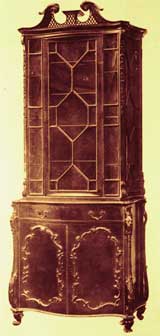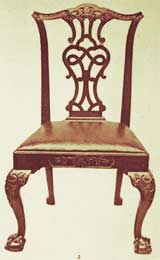Chippendale Furniture Style
Thomas Chippendale, the Georgian master, has drawn inspiration from many furniture styles, which he adapted with a remarkable versatility. In the beginning, he created under the influence of the Dutch school of the early Georgian style period, but afterwards his skills took him in a journey through the rococo, Louis XV, the Chinese and Gothic styles, finally leading up to the classic and Louis XVI.
He had an ability to combine apparently inconsistent elements in a harmonious whole. His carving skills were of the highest order. His daring designs varied from the bizarre to the exquisite.
Chippendale was the dominant figure in English furniture design for a quarter of a century, till about 1770. The first edition of his design book, "The Gentleman and Cabinet-Maker's Director," appeared in 1753. Very well received by the public, the book will record its third edition in 1762.
Chippendale impressed his personality on the styles of the period more than any other designer of furniture.

Chippendale Style Bookcase, Mahogany
He began first with furniture works in Queen Anne style, with bandy-legged, fiddle-backed chairs. These pieces had a very broad seat and ball-and-claw feet. Gradually, he improved his cabriole leg, and gave up the Queen Anne style chair- backs for a squarer form with round corners.
Soon, he created the bow-shaped or slightly curved top rail which is associated with his name. Some authors are attempting to divide Chippendale’s work into three periods: Anglo-Dutch, French, and Chinese-Gothic. However, his works did not exhibit such sharp differences as to grant this division.
From about 1745, his furniture design was mainly influenced by the Louis XV style, and he will continue to create in the French manner till the day of his death. On this note, his best works are the French designs of 1750-60. After that period, the combination of rococo with Chinese and a bit of Gothic proved too much for him.
Chippendale Chairs
The typical Chippendale chair-back had a moderately carved frame, rectangular in shape, and a pierced splat, developed from that of the Queen Anne period.

Chippendale Style Chair
This type of splat appeared before in the chairs of the Dutch type and in those of the Louis XV type, including the famous ribbon-back chairs.
He also made a roundabout chair using these splats models. It was almost as familiar as the ladder-back chair, with its four or five bow-shaped cross-pieces.
Chippendale did not use only the cabriole leg with his French chairs, but also the straight, square legs that also appear on his other types. The seats of his chairs were usually wide, square cornered, and upholstered. Some of these chairs were made with under braces, some without them.
The master’s work included a wide variety of card-tables, sofas, settees, desks, bureaus, secretaries, bookcases. Chippendale was a master-carver, and seldom, if ever, he used inlay for decoration. When he started his career with the Dutch inspired designs, he used mainly walnut. But mahogany will become his preferred wood. He also used maple, cherry, and birch. His expertise covered everything furniture, and he published designs for clock-cases and mirror frames.
The furniture belonging to the end period of Chippendale’s career exhibited a style deterioration, with a leaning toward grotesque mixtures of styles.
